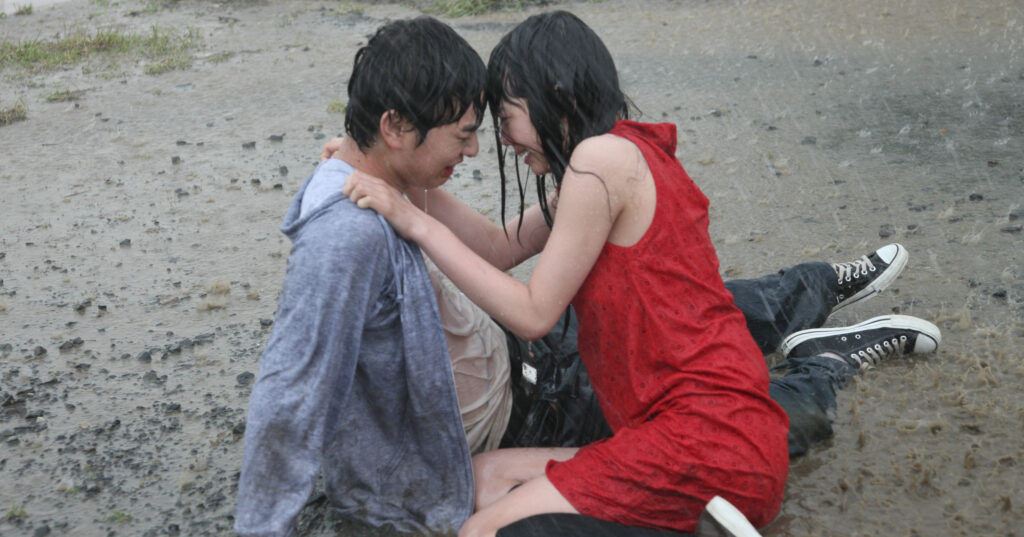Sion Sono’s near-masterpiece Himizu takes place in the shadow of the 2011 Tohoku earthquake and tsunami and ensuing Fukushima Daiichi nuclear meltdown, the largest such event since Chernobyl in 1986. The disaster left the surrounding area and national psyche ravaged, but if we’re to believe the film’s pessimistic view of Japanese society, Fukushima Daiichi wasn’t the only toxic thing about contemporary Japan. An unabashedly gloomy coming-of-age tale, Himizu turns a scornful eye toward a culture that promotes individualism while simultaneously hindering it, all while making bracing visual allusions to the widespread destruction of the Tohoku earthquake. Residing in a shoddy lakeside shack with his neglectful mother, 14-year-old Sumida (Shota Sometani) runs his family’s boat-rental business alongside a colorful group of squatters living nearby, in a makeshift shantytown. Scenes that feature Sumida and his chums kicking back and shooting the shit play like something out of Judd Apatow, affable in their relaxed air and congenial character interplay. These visits are often interrupted by Sumida’s alcoholic, sociopathic father, who returns to the shack only to take some money and knock his son around, disparaging him with a barrage of unbelievably cruel comments.
Abrupt shifts from tender comedy to jarring violence are found throughout Himizu, which dexterously balances an array of tones. The would-be meet cute between Sumida and the doting Keiko (Fumi Nikaido, the film’s best performance) starts out sweet before turning hostile. In Sono’s hands, quicksilver mood swings barely register, but nevertheless deliver a heavy blow. Violence is prevalent throughout Himizu, and becomes a byproduct of the narrative and characterizations; its presence is always alarming, even as it’s carried out by the characters in the most banal ways imaginable. As the story grows increasingly intense—one of Sumida’s cronies, the elderly and sweet-hearted Yoruno (Tetsu Watanabe), robs an affluent neo-Nazi to help pay a debt Sumida’s dad owes to the Yakuza, the ramifications of which send both characters into a nihilistic spiral—so too does the violence. Rather than offering up empty shock value, however, the brutality feels suitable, even logical, a disarmingly experiential ploy that implicates the audience in its acceptance of violent images.
Himizu turns a scornful eye toward a culture that promotes individualism while simultaneously hindering it.
Lest that make the film sound like some sort of Haneke-esque parlor game, Himizu’s concerns are ultimately sociocultural. Before everything goes haywire, Sumida desires a life of isolation, desperate to avoid the seemingly inevitable turmoil that accompanies intimate relationships and nuclear families. He openly rebukes notions of individualism and Japanese exceptionalism as posited by his gung-ho schoolteacher, who believes so thoroughly that each person is a “unique flower” that he demands the class repeat it, in unison, effectively negating the individualistic sentiment. Sumida’s response: “Ordinary is best.”
Except when it isn’t. Indeed, a sense of identity eludes Sumida and each of the characters here in one way or another. The final lines of a poem by Francois Villon are repeated throughout the film: “I know flies in milk. Specks against white. I know who labors and who loafs. I know pink cheeks from wan. I know death, who devours all. I know all save myself.” This refrain becomes a veritable mantra for Sono’s characters, and a sort of unofficial slogan for Japan itself, a nation which appears here to be in an alternate state of transition and turmoil. A general sense of menace presides over the second half of Himizu, in which knife-toting men seem to roam the land with impudence. After attempting to murder a busking guitar player, one of these presumed maniacs asks “Who am I?” And that’s the overriding question for a society whose violent tendencies and sense of uncertainty can be traced back, as the school teacher interestingly notes, to World War II. (Suddenly, the strange presence of the aforementioned Nazi sympathizer makes more sense.) In the wake of a national crisis, the question of “Who am I?” becomes more pressing than ever, and Sono’s response can be found in the reiterated shots of tsunami-inflicted rubble: a chance at redemption lying among the ruins.


Comments are closed.